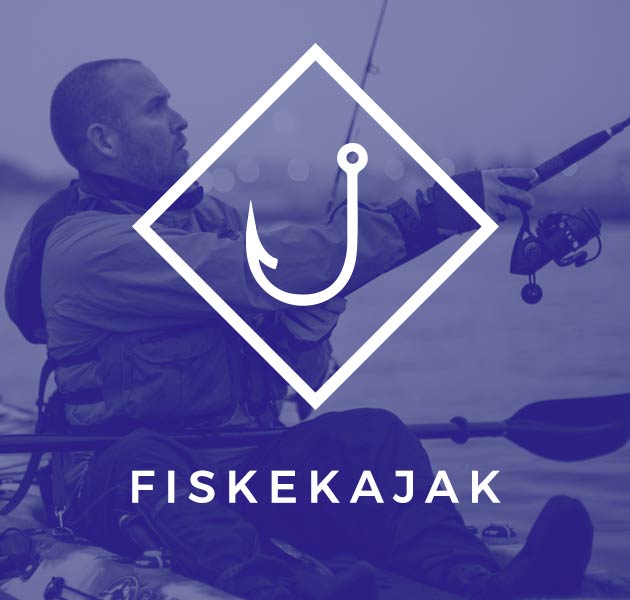No products
Product successfully added to your shopping cart
There are 0 items in your cart. There is 1 item in your cart.
Kayak Fishing
 Styles of fishing from a kayak
Styles of fishing from a kayak
Kayak fishing is fishing from a kayak. The sport has gained in popularity in recent years due to its appeal as a healthy sport and relative low cost of entry.
There are different styles of kayak fishing and the following should not be taken as an end all list but more of a guideline of what is popular and what we tend to do. Depending on where you fish and which methods you use, there is a huge variety of fish you will be able to catch. We totally appreciate everyone has different views on the topic but we thought this information could be of use to people who are interested in starting kayak fishing.
Fishing enthusiast’s keep on developing new styles and variations and that is part of the beauty of the sport! We encourage people to try new things and discover what works best for them in different environments.
Jigging from a kayak
Jigging is a method of fishing using a jig; a special type of lure. The technique requires you to drop your lure to the bottom and then reel up using a jigging motion (that’s where the name comes from!).
The lures usually come in the form of a weight that is shaped like a species of bait, such as a fish or octopus. The jig is a versatile set up that can be used in both fresh and salt water. For kayak fishing you use weights between 80 grams and 150 grams (give or take).
You can also add feathered hooks above the jig so that it looks as if the jig is a predator, chasing the smaller feathered hooks, and adds to the variety of fish you can catch.
Through this method you can expect to catch deeper water predators that live in that area although this can still be varied depending on the depth of the jig etc. In our area of Spain you can catch the following species of fish using a jig with more depth: Dentex, Snappers, Red Sea Bream, Tub Gurnard, Sea Bass and Groupers. With lighter jigs and less depth you can catch Sea Bass, Baila, Mackerel, Horse Mackerel, Pandora and Weeverfish.
Trolling (fishing) from a kayak
Fishing kayaks, such as the ones listed here on our site, have rod holders that are built in to the kayak. You attach a lure onto the fishing rod that is specific to the type of fish you want to attract. There are countless variations of lures used, some are weighted and others are not, some swim closer to the surface and others dive down deeper. Each setup is designed to attract certain species of fish.
You then place the rod or even two rods in the rear rod holders and using the paddle start paddling ahead and picking up speed. This motion makes the lure swim behind the kayak and attracts various surface level predators.
This particular style of fishing is popular for catching migrating predators such as: Marlin, Tuna and Barracuda but you can also catch Sea Bass, Baila, Dentex and Weeverfish.
If you set your brake fairly loose, once you get a bite you will immediately feel it and hear it too! This method is also a fantastic way of getting a good workout!
Using baited hooks from a kayak
Using baited hooks involves fishing using small bait as a lure on a hook. This varies depending on where you are fishing and for what type of species but can include varieties of worms, shrimp and sardines.
This method of fishing is probably one of the most popular methods and allows for a huge possibility of fish to catch, including all of the species above, as well as: Gilt Head Fish, White Sea Bream, Saddled Sea Bream and Triggerfish.
Live bait from a kayak
Live bait is the act of using live bait as a lure for fish. You usually catch your own live bait, such as small fish or octopus, by jigging or trolling (or of course you can purchase some). You then put a hook through it; one method is through its dorsal fin and mouth and then drop it down using a weight.
There usually is a weight attached at the bottom of the line, half a metre of line, then there’s two round swivels and one round swivel that goes out to the side. And on the one that comes out to the side you attach the live bait, which swims around the weight.
This method is probably the most difficult but is also incredibly exciting. The difficulty lies firstly in the ability to keep the bait alive and secondly in the ability to handle a big predator. Through this method there’s a huge array of fish you can catch, depending on the bait used, but some examples include: Red Sea Bream, Dentex, Skip-Jack Tuna, Common Sea Bream, Sea Bass and Tuna. Bites can be fast and you must always keep an eye on your rod because of the speed at which battles can commence.
Keeping bait live for long stretches on a kayak can be complicated. Galaxy Kayaks was the first to develop and incorporate live bait wells with a scupper filter aeration system.
The live bait well is available in our Galaxy Alborán fishing kayak. This is a simple design where the inside of the centre hatch is moulded with a containment bucket. The bait bucket has a scupper hole at the bottom with a plug. When the plug is removed the bucket fills with water and the live bait can be placed within it. Depending on the weight of the loaded kayak the water will fill to different heights. The scupper plug stays open and as the kayak moves, the water is constantly being renewed and oxygenated. If you plan on fishing with smaller fish that could fit through the holes, be sure to place a filter in the holes to prevent them escaping. You can also keep the plug closed and fill the bucket manually, but be sure to open the plug every so often to release the old water and manually re fill with fresh oxygenated water.
For this method of fishing it is recommended that you use a stronger rod and reel as you never know what size fish you’ll hook.
Rods and reels to use for kayak fishing
We would recommend using a rod of no longer than 2m in length. This is so that you can reach the end of your rod whilst on a kayak in case of tangling or any issues that can occur while you’re out on the water. There are specially designed kayak fishing rods that take all that into consideration for you. Some people do use longer ones but they are usually telescopic rods and they can bring them in.
Your reel doesn’t require a lot of line, and therefore can be smaller and stronger, such as small ocean reels; which are lighter too. This is particularly useful for jigging that can be tough on the arms. In European waters you will be going out to depths of maximum 40-60m which means a line of at least 100-150m will be sufficient.
Our set up
For jigging and bait fishing you can use a thin rod and light reel.
For live bait and trolling you need a thicker rod and bigger reel as you generally go for bigger species.
Therefore we would recommend one light rod for jigging and a stronger rod and reel for trolling and live bait fishing.

Pricing
A light jigging rod and bait fishing can cost between 60-160 euros
A good quality reel for light jigging and bait fishing can run between 80-180 euros
For trolling or live bait a good rod will cost between 100-160
A good quality reel for trolling or live bait can go from 100-250+
Word of warning – keep your gear clean
Always maintain your gear by giving it a wash after use. If you plan on doing salt-water fishing remember to purchase gear that can cope with salt and always clean it with fresh water and to the products recommended instructions.
Rules and regulations
There are rules and regulations around fishing and these vary by country and sometimes region. Please do some research before heading out and inform yourself on what is needed to fish in your area.
In Spain you require a license for both salt and freshwater kayak fishing. Peskama have put together a fantastic resource on rules and regulations we recommend you read Peskamas list of regulations.
Vulnerable Species
The severity of the world’s current environmental situation is increasingly worrying for all of us. Climate change, the destruction of marine habitats through trawling and water pollution and the threat over-fishing has on our waters are all key issues that are close to our heart.
We believe that recreational kayak fishing draws people closer to mother nature and allows them to experience our position in the world. We believe in protecting species at risk and recommend all of our customers who want to fish to inform themselves about vulnerable species in their area.
We strongly promote catch and release fishing. Using your wit, talent and experience to catch fish makes it a wonderful sport. Taking that proud picture is a way of measuring that experience and sharing it with others. Releasing the fish back into the water is showing ultimate respect for that fish and the planet we live on. A wise man once said we don’t inherit the world from our parents, we borrow it from our children. Lets make sure our children can share in the great adventure that is fishing and lets help spread the message of responsible fishing.
For more information on threatened species visit IUCN Redlist.
All Team Galaxy members abide by the rules and regulations in their area. The team mostly practice catch and release fishing yet at times harvest fish to eat themselves.
Our ethos is about appreciating and respecting nature. If you make the choice to eat fish, we understand it is better to source it locally and yourself, as long as it is not a species at risk and follows the local rules and regulations.
Educate yourself, be responsible and respect Mother Nature.
Learn from others
There are lots of different ways to meet people who are kayak fishing and we believe this is the best way to develop your skills. Kayak fishing clubs are popular and can be found by a simple online search of your area.
There are also forums online dedicated to kayak fishing and they too can be good sources of local information. Add to this the many blogs available, where you can revel in great articles from people with a passion for this great sport. If you’re interested, have a look at our blog.
Here are two forums we follow:
There are plenty more out there, have a look locally and we’re sure you’ll find some.
Kayak fishing with other people is also safer and much more fun and you will make some excellent friends in the process!

Safety first
Kayaking is a high-risk sport. It is very important to have basic safety training before heading out on a kayak.
Galaxy Kayaks is not responsible for your safety or training. We ask that you take all necessary safety precautions and have maximum respect for the power of nature.
Here are some simple rules to help your confidence on the water:
- Never go kayaking alone
- Never go out without a personal floatation device
- Obtain certified first-aid training
- Learn and practice how to get in and out of your kayak from out in the water
- Wear appropriate clothing and dress for weather and water conditions
- Never leave without checking all your equipment
- Never go out in dangerous conditions
- Never paddle in flood conditions
- Never leave without checking the weather conditions
- Be aware of river water levels, tidal changes, dangerous currents, underwater hazards, and weather changes
- Always notify friends and family of where you go and how long it will take
- Make sure your mobile phone is well stored in a waterproof bag
- Always take a radio with you to communicate with fellow paddlers and the coastguard
- Always take all necessary safety equipment: knife, flashlight, whistle etc...
- Never go without necessities like water, sun cream, a hat, sun glasses and some high energy food (like an energy bar)
Kayaking is a very fun and healthy sport. It's a great way to get in shape and enjoy the water at the same time!
There are new adventures waiting to be had with Galaxy Kayaks…go seize them!




